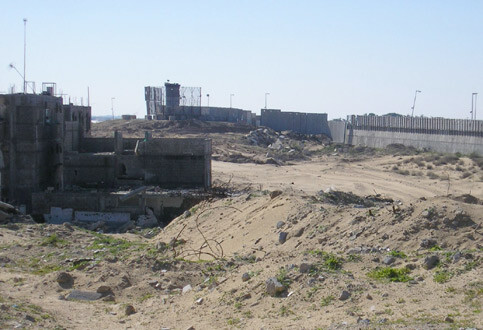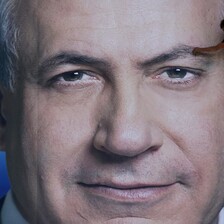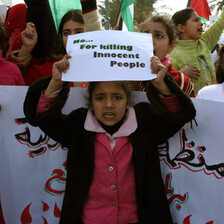
A huge, 50-foot-high concrete wall separates the Gush Katif settlement bloc from Khan Yunis. Palestinian land between the Israeli settlement and Khan Yunis has been destroyed. (Arjan El Fassed)
There is certainly something in the air. Gunfire, cheering - general celebrations. Outside the al Shawa Convention Centre in the heart of el-Rimal distract of Gaza City there are marches - last night by Islamic Jihad - to celebrate the redeployment of the Israeli military. On Friday Fatah held another demonstration in Gaza City. Hamas have been practising for redeployment all week by letting off random explosions. Each side is trying to claim the redeployment for its own.
The PLO Flag Shop in Gaza City is decked out with special t-shirts celebrating what they call “withdrawal”. There are Palestinian flags hanging outside the shop with “FREE GAZA” printed on them in black.
I can’t help but feeling like the grumpy old neighbour who pulls the plug on the music sound system during the best party you’ve ever been at. I constantly ask people, and myself: why all the celebrations - what is all the excitement for? In fact - as I pull the plug on the sound system - the Israeli military are preparing to become the Doctor who pulls the plug on the life support machine.
It has been well recorded, by now, that Dov Weisglass (Sharon’s Chief Advisor) has already stated that disengagement is about putting an end to the peace process and to placing any possibility of having a Palestinian state in “formaldehyde”. Formaldehyde it should be remembered is what they store dead bodies in.
The excitement on the streets of Gaza City belies the real fact that while Sharon’s troops redeploy to the edges of the Gaza Strip (keeping control over the air-space, the sea-space and the land borders) they maintain the occupation of it. While maintaining the occupation of the Gaza Strip (by retaining effective military and administrative control, in international law terms) Sharon is cementing control of the West Bank - finishing, even polishing, his Annexation Wall in the West Bank and truncating Jerusalem from the rest of the Occupied Palestinian Territory.
This creates a substantial distance between the Gaza strip, the West Bank and occupied east Jerusalem. After disengagement civilians will be able to move freely between the north and the south of the Gaza Strip. However, moving to outside the Gaza Strip will be even more difficult then it is now. The Israeli military is constructing another series of fences and ditches, 10 metres wide, from the border of the Gaza Strip inside Israel. This electronic fence will consist of remote control armoured vehicles which will be operated from Tel Aviv - monitored by sophisticated cameras. The vehicles will be able to fire into the Gaza Strip. At the same time Unmanned Aerial Vehicles (or Drones) will be operating above the skies in Gaza in keeping with Sharon’s commitment to Bush that Israel would “reserve the right” to carry out incursions at any time inside the Gaza Strip. At the same time Rafah crossing - the only access point to the outside world - will still be controlled by the Israeli military so re-enforcing the physical and psychological distance between Gaza and the rest of the OPT.
In Gaza now the checkpoints are closed to prevent movement of students, workers, sick people and whoever might just want to see their friends or visit their family. So we watch the disengagement on the television like the rest of the world. We will see the same images taken by the 50 embedded journalists every day. (Out of 4000 journalists who tried to come to Gaza only 50 will be allowed each day into the settlements - 35 Israelis, 10 randomly selected foreign correspondents and 5 international journalists which Israel has a “special interest” in allowing into the settlements). Yesterday the people in Gaza were glued to the images of settlers trundling past the al Jazeera cameras for hours on end. Sometimes in Gaza the things which happen down the road seem more distant then those which happen hundreds of miles away.
There is some excitement which can be justified by the redeployment - that is for those Palestinians who live in the sealed enclaves. These sealed areas are surrounded by illegal Israeli settlements. They are home to thousands of Palestinians in the Gaza Strip who have electronic id. cards and who are only able to pass through one checkpoint with heavy restrictions on their freedom of movement. While on a trip to the checkpoint of one of these areas recently - al Toofah checkpoint at the entrance of al Mawasi - I witnessed residents of al Mawasi who were waiting for three and four days on end in the blistering sun before being allowed to pass. These same residents can only look forward to the ‘disengagement’. In Palestine only their lives will change substantially - as they move from solitary confinement back into the rest of the prison.
Eoin Murray is an Irish Human Rights worker, based in Gaza City. He is researching on the position of Human Rights Defenders in the occupied territories for Front Line, the International Foundation for the protection of Human Rights Defenders.
Related Links




